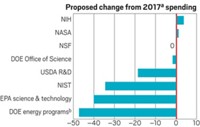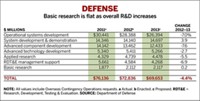Advertisement
Grab your lab coat. Let's get started
Welcome!
Welcome!
Create an account below to get 6 C&EN articles per month, receive newsletters and more - all free.
It seems this is your first time logging in online. Please enter the following information to continue.
As an ACS member you automatically get access to this site. All we need is few more details to create your reading experience.
Not you? Sign in with a different account.
Not you? Sign in with a different account.
ERROR 1
ERROR 1
ERROR 2
ERROR 2
ERROR 2
ERROR 2
ERROR 2
Password and Confirm password must match.
If you have an ACS member number, please enter it here so we can link this account to your membership. (optional)
ERROR 2
ACS values your privacy. By submitting your information, you are gaining access to C&EN and subscribing to our weekly newsletter. We use the information you provide to make your reading experience better, and we will never sell your data to third party members.
Policy
Defense: Cuts Hit Systems Development
by Andrea Widener
April 22, 2013
| A version of this story appeared in
Volume 91, Issue 16
The Department of Defense’s R&D budget dwarfs all other federal research combined, but it has not been spared the ax in President Obama’s proposed 2014 budget.
The DOD R&D budget is facing overall cuts of 7.5%, down from $73.0 billion in 2012 to $67.5 billion in 2014. That includes a decreasing amount of Overseas Contingency Operations funds, which were dispersed throughout the department to help support the wars in Iraq and Afghanistan. The 2014 cuts mostly come in the development side of the R&D equation, decreasing the amount spent on transitioning research programs into production.
The situation is better for DOD’s research portfolio. The three military branch research labs—the Army, Air Force, and Navy—will receive $2.2 billion each, flat funding compared with 2012. They have been hit hard by the across-the-board budget cuts called sequestration because many of the scientists working in those labs are civilian employees and thus subject to furloughs, unlike military personnel.
In keeping with the President’s overall support of basic science, DOD’s basic research budget would get a 7.7% increase from 2012 to $2.2 billion in 2014. The focus would be on high-priority areas, including cybersecurity, robotics, advanced learning, “big data,” energy efficiency, advanced manufacturing, and biodefense.
The Defense Advanced Research Projects Agency (DARPA), which funds high-risk basic research projects, also avoided the budget ax. It would get $2.9 billion in 2014, up 1.8% from 2012.
A big chunk of the DARPA increase will go toward the President’s proposed Brain Research through Advancing Innovative Neurotechnologies (BRAIN) Initiative, which he announced this month. With a proposed investment of $50 million, DARPA will support technologies designed to study how the brain works.
MORE ON THIS STORY
- - Science Funding
- - NSF: Basic Science Set To Grow
- - NIH: Funding Remains Flat, But Offers Relief From Sequestration
- - Defense: Cuts Hit Systems Development
- - DHS: Huge Jump To Support New Biocontainment Lab
- - Energy: Renewable Energy Set For Boost
- - NASA: Support To Enable Future Asteroid Mission
- - Commerce: NIST, NOAA Get Budget Hikes
- - Agriculture: Competitive Research Funds Set To Rise
- - EPA: Research On Contaminated Sites Scaled Back
- - Interagency Initiatives: Education Reshuffled, Climate Up, Nanotech Reduced
- - FDA User Fees Continue To Climb






Join the conversation
Contact the reporter
Submit a Letter to the Editor for publication
Engage with us on Twitter